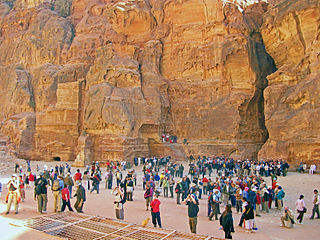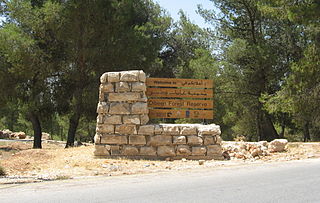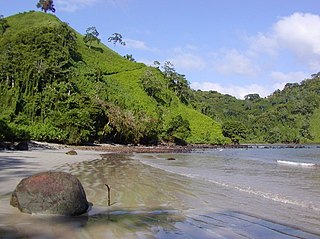
Ecotourism is a form of nature-oriented tourism intended to contribute to the conservation of the natural environment, generally defined as being minimally impactful, and including providing both contributions to conservation and environmental education. The definition sometimes also includes being financially beneficial to the host community or making conservation financially possible. There are a range of different definitions, and the correct definition of the term was an active subject of debate as of 2009. The term is also used more widely by many organizations offering nature tourism, which do not focus on being beneficial to the environment.

A nature reserve is a protected area of importance for flora, fauna, funga, or features of geological or other special interest, which is reserved and managed for purposes of conservation and to provide special opportunities for study or research. They may be designated by government institutions in some countries, or by private landowners, such as charities and research institutions. Nature reserves fall into different IUCN categories depending on the level of protection afforded by local laws. Normally it is more strictly protected than a nature park. Various jurisdictions may use other terminology, such as ecological protection area or private protected area in legislation and in official titles of the reserves.

Dana is a village near the city of Tafilah, in the Feynan area in central-western Jordan. It is situated on the edge of Wadi Dana, a large natural canyon, and has views over Wadi Araba. It is host to Dana Biosphere Reserve, one of Jordan's premiere nature reserves with ecotourism facilities.
The Royal Society for The Conservation of Nature (RSCN) is an independent voluntary organization that is devoted to the conservation of the county of Jordan's natural resources; it was established in 1966 with King Hussein as Honorary President.

The Wadi Mujib, also known as Arnon Stream, is a river in Jordan. The river empties into the Dead Sea circa 420 metres (1,380 ft) below sea level.

Jordan is a sovereign Arab state in the Middle East. The capital, Amman, is Jordan's most populous city as well as the country's economic, political and cultural centre.

Tourism in Nicaragua has grown considerably recently, and it is now the second largest industry in the nation. Nicaraguan President Daniel Ortega has stated his intention to use tourism to combat poverty throughout the country.

The wildlife of Jordan includes its flora and fauna and their natural habitats. Although much of the country is desert, it has several geographic regions, each with a diversity of plants and animals adapted to their own particular habitats. Fossil finds show that in Palaeolithic times, the region had Syrian brown bears, Asiatic lions, zebras, Asian elephants, and rhinoceroses, but these species are all now extinct in this region.

Ecotourism is the concept of responsible trips and travel to areas that might be protected and especially fragile. The intent is to create as little detrimental impact on the environment as possible. South Africa has used ecotourism to sustain and improve its immense biodiversity, as well as invigorate its economy. Tourism is the fourth largest generator of foreign exchange in South Africa, and ecotourism is the idea of encouraging visitors while promoting and supporting a country's biodiversity. South Africa contains a lot of biodiversity, and so ecotourism is a way for the country to benefit from wildlife in a non-consumptive and legal manner as opposed to illegal activities like poaching and trafficking for the international wildlife trade.

Rural tourism is a form of tourism that focuses on actively participating in a rural lifestyle. It can be a variant of ecotourism, emphasizing sustainable practices and community involvement. Many villages can facilitate tourism because of the hospitality and eagerness of villagers to welcome or host visitors. The mechanization of agriculture has reduced the need for manual labor, leading to economic pressures on some villages and prompting young people to migrate to urban areas. However, a segment of the urban population is increasingly interested in visiting rural areas to experience and understand the rural lifestyle.

The Dana Biosphere Reserve is Jordan's largest nature reserve, located in south-central Jordan. Dana Biosphere Reserve was founded in 1989 in the area in and around the Dana village and Wadi Dana comprising 308 square kilometres (119 sq mi).

Dibeen Forest Reserve is a nature reserve located in the north-west of Jordan. It is situated just south of the Roman site of Jerash and covers an area of 8.5 square kilometres (3.3 sq mi) of rolling hills covered with pine–oak habitat. This area houses the largest Aleppo Pines one of the oldest and naturally grown habitats in Jordan. It also is the home to 17 endangered species such as the Persian Squirrel.

There are at least seven nature reserves in Jordan. In 1966, the organization that would later start Jordan's nature reserves, the Royal Society for the Conservation of Nature, was founded. RSCN's first efforts involved bringing back severely endangered species. In 1973, RSCN, was given the right to issue hunting licenses, giving RSCN an upper hand in preventing extinction. The first step was the founding of Jordan's first nature reserve, Shaumari Wildlife Reserve, in 1975. The primary purpose was to create means to breed endangered species, specifically: the Arabian oryx, gazelles, ostriches and Persian onagers in their natural environment.

The Ajloun Forest Reserve is a nature reserve located in the Ajloun Governorate in north-west Jordan. Established by the Royal Society for the Conservation of Nature in 1988 in the area around the village of Umm Al-Yanabi, it comprises an area of 13 square kilometres (5 sq mi). The reserve is houses a captive breeding programme for the locally extinct roe deer and has been declared an Important Bird Area by BirdLife International. There are also a number of hiking trails for tourists.
The first USAID funded Jordan Tourism Development Project ran for three years (2005–2008) providing technical assistance, training and other services to help Jordan implement its National Tourism Strategy designed to double tourism receipts by 2010. It promoted Jordan’s competitiveness as an international tourism destination by establishing a strong institutional and regulatory framework that promoted private-sector investment, stimulates tourism growth and preserves national tourism assets and the environment.

Ecotourism is a key component of the tourism industry in Costa Rica. By the early 1990s, Costa Rica became known as the poster child of ecotourism. The country is among many developing nations that look to ecotourism as a way of cashing in on the growing demand for this popular trend of travel.

Jordan has been granted considerate amounts of international aid moneys toward environmental conservation. Foreign aid goes into mitigation projects in the areas of water scarcity, loss of arable land for agriculture, and renewable energy. Moreover, foreign aid goes toward the development of the eco-tourism sector. Jordan receives aid from different kinds of international agents. Principal institutions that donate money toward environmentalism in Jordan are the Global Environmental Facility (GEF), United States Agency for International Development (USAID), and World Bank. Recently, Jordan has had problems to control its budgetary deficit, which directly affects its ability to manage its environmental problems. That has made some point out that Jordan depends on International aid to control environmental-related issues. One of the examples of that is related to the construction of the East Ghor Canal.

Wadi Feynan or Wadi Faynan is a major wadi and region in southern Jordan, on the border between Tafilah Governorate and Aqaba and Ma'an Governorates. It originates in the southern Jordanian Highlands with the confluence of Wadi Dana and Wadi Ghuweyr, and drains into the Dead Sea via Wadi Araba.

Ecotourism in Mexico is tourism that sustainably experiences fragile, pristine and relatively undisturbed natural areas. Tourism is a large sources of revenue for Mexico Ecotourism has received mixed responses, but organizations such as the Organization for Economic Co-Operation and Development (OECD) stressed its importance in the long-term economic health of Mexico.

Ammar Khammash is a Jordanian architect, designer and artist. His work is based on the integration of building designs with nature and the surrounding environment. His projects helped revive Pella and Jordan Valley by creating two rest stops.


















